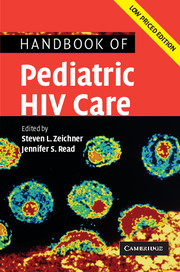Book contents
- Frontmatter
- Contents
- List of contributors
- List of abbreviations
- Foreword
- Preface
- Part I Scientific basis of pediatric HIV care
- 1 The scientific basis of pediatric HIV care
- 2 The epidemiology of pediatric HIV disease
- Part II General issues in the care of pediatric HIV patients
- Part III Antiretroviral therapy
- Part IV Clinical manifestations of HIV infection in children
- Part V Infectious problems in pediatric HIV disease
- Part VI Medical, social, and legal issues
- Appendix 1 Formulary of antiretroviral agents
- Appendix 2 National Institutes of Health sponsored clinical trials for pediatric HIV disease
- Appendix 3 Selected HIV-related internet resources
- Appendix 4 Selected legal resources for HIV-infected children
- Index
- References
2 - The epidemiology of pediatric HIV disease
Published online by Cambridge University Press: 23 December 2009
- Frontmatter
- Contents
- List of contributors
- List of abbreviations
- Foreword
- Preface
- Part I Scientific basis of pediatric HIV care
- 1 The scientific basis of pediatric HIV care
- 2 The epidemiology of pediatric HIV disease
- Part II General issues in the care of pediatric HIV patients
- Part III Antiretroviral therapy
- Part IV Clinical manifestations of HIV infection in children
- Part V Infectious problems in pediatric HIV disease
- Part VI Medical, social, and legal issues
- Appendix 1 Formulary of antiretroviral agents
- Appendix 2 National Institutes of Health sponsored clinical trials for pediatric HIV disease
- Appendix 3 Selected HIV-related internet resources
- Appendix 4 Selected legal resources for HIV-infected children
- Index
- References
Summary
Introduction
Worldwide, over 3.2 million children are living with HIV and at least 1700 babies are born each day with HIV infection [1]. Mother-to-child transmission (MTCT) of HIV represents the most common means by which children become infected with HIV. This chapter will review the current epidemiology of HIV infection in children in the USA, and briefly review the growing worldwide impact of HIV on children.
HIV/AIDS among children in the USA
HIV infection and AIDS reporting
Through June 2001, 8994 US children with AIDS were reported to the US Centers for Disease Control and Prevention (CDC) from all 50 states, Puerto Rico, the District of Columbia, and the US Virgin Islands (Table 2.1). Fifty-six percent of all cases were reported from only four states: New York (25%), Florida (16%), New Jersey (8%), and California (7%). The majority of AIDS cases (91%) and virtually all new HIV infections resulted from MTCT. Seven percent of children with AIDS acquired their infection through receipt of contaminated blood or blood products. AIDS also has been reported among children who acquired HIV infection from sexual abuse, mucus membrane exposure to blood, and percutaneous or cutaneous exposures to blood or contaminated needles during home health care [2]. Only 2% of AIDS cases in US children lack an ascribable risk, usually because of incomplete information about the mother [3].
- Type
- Chapter
- Information
- Handbook of Pediatric HIV Care , pp. 78 - 96Publisher: Cambridge University PressPrint publication year: 2006



